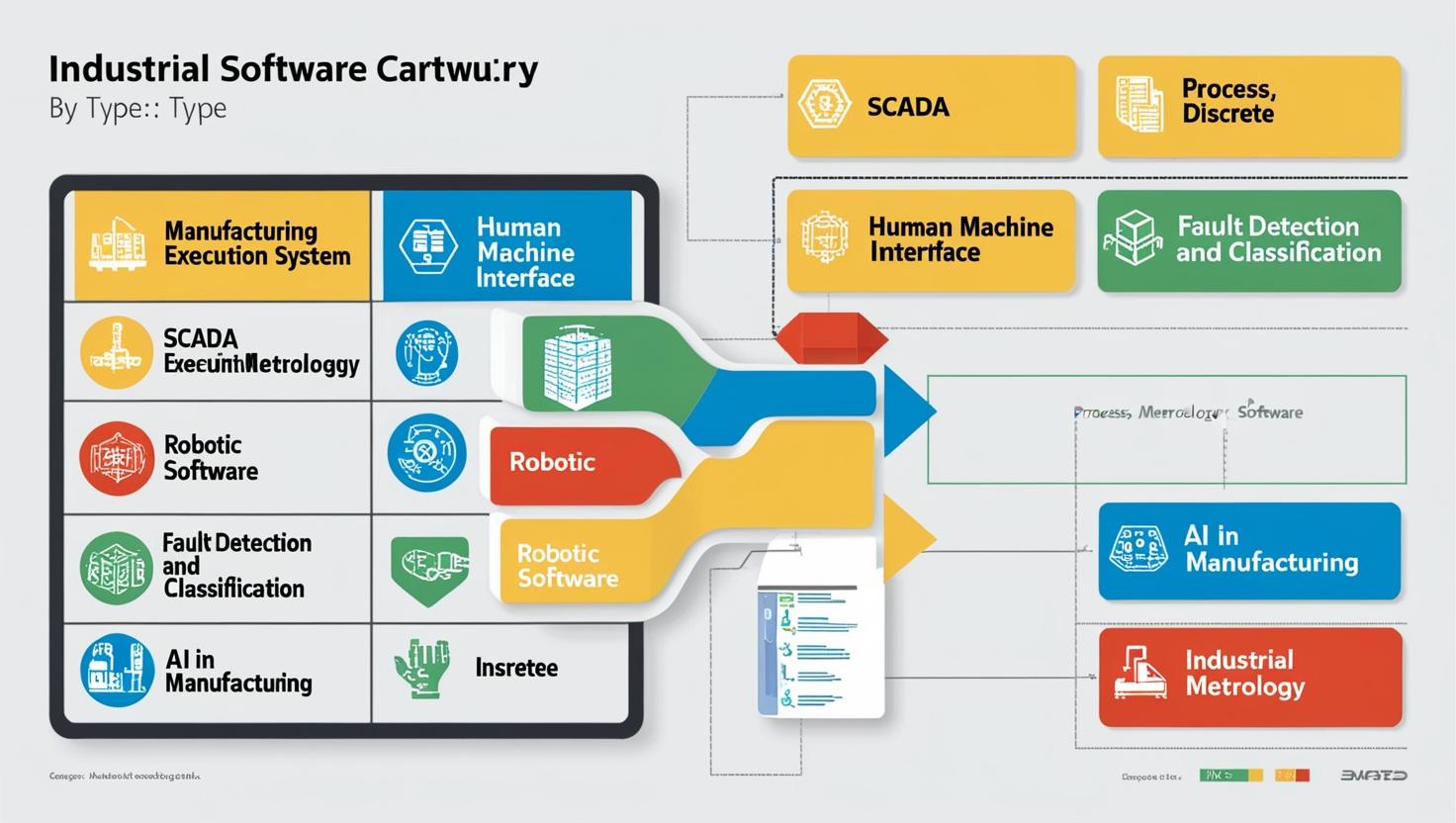The Industrial Software Market is undergoing a dynamic transformation, fueled by the convergence of Artificial Intelligence (AI) and the Internet of Things (IoT). As manufacturers and industrial enterprises embrace digitalization, AI and IoT integration is emerging as a game-changer—unlocking new efficiencies, enabling predictive operations, and redefining the way industries monitor, analyze, and automate.
From smart factories to connected supply chains, AI and IoT are not only reshaping industrial ecosystems but also significantly accelerating the expansion of the Industrial Software Market.
The Evolving Role of Industrial Software
Industrial software encompasses a range of applications used to design, manage, and optimize industrial operations. These include Manufacturing Execution Systems (MES), Supervisory Control and Data Acquisition (SCADA), Product Lifecycle Management (PLM), Enterprise Asset Management (EAM), and more.
The rising need for real-time data analysis, automation, and intelligent decision-making is pushing industries to upgrade from legacy systems to more adaptive, cloud-enabled, and intelligent platforms. This demand is one of the key factors propelling the Industrial Software Market globally.
How AI Is Powering Smarter Industrial Decisions
AI brings advanced capabilities like machine learning, natural language processing, and data pattern recognition into industrial workflows. When embedded into industrial software systems, AI algorithms can:
-
Predict equipment failures through predictive maintenance
-
Optimize production schedules and reduce downtime
-
Improve quality control by analyzing sensor data in real time
-
Enable adaptive manufacturing with autonomous decision-making
By turning massive volumes of machine and process data into actionable insights, AI helps industrial businesses reduce operational costs and enhance productivity—two critical drivers behind the growth of the Industrial Software Market.
Download PDF Brochure @ https://www.marketsandmarkets.com/pdfdownloadNew.asp?id=27555137

IoT: The Foundation of Connected Industry
IoT plays an equally vital role by creating a network of interconnected machines, sensors, and systems that communicate in real time. This continuous data stream feeds into industrial software platforms, enabling live tracking, condition monitoring, and remote control of assets.
With IoT integration, manufacturers gain:
-
Enhanced visibility into operations
-
Better energy efficiency and resource utilization
-
Real-time alerts and anomaly detection
-
Seamless integration of supply chain and logistics
As more industrial devices and systems come online, the demand for scalable, secure, and intelligent software solutions grows—further expanding the Industrial Software Market footprint across sectors like automotive, aerospace, energy, pharmaceuticals, and electronics.
The Rise of Industrial IoT (IIoT) Platforms
The combination of AI and IoT is giving rise to Industrial IoT (IIoT) platforms—comprehensive environments that collect, analyze, and act on data across the entire production lifecycle. These platforms serve as a digital backbone for smart manufacturing, driving automation and digital twin technologies.
Industrial software vendors are rapidly evolving to offer IIoT-ready solutions that support edge computing, machine learning, and cross-facility integration. The result is faster data processing, decentralized decision-making, and enhanced agility—key features that are reshaping the Industrial Software Market landscape.
Cloud Computing and Scalability
Another factor accelerating market growth is the shift to cloud-based industrial software. Cloud deployment offers scalability, lower upfront costs, and the ability to integrate AI and IoT services more efficiently.
Industrial enterprises are now favoring hybrid cloud environments to deploy AI-enhanced software with IoT compatibility, making data and insights accessible across global locations. This agility is critical for companies navigating supply chain volatility and shifting customer demands.
As cloud adoption increases, it is expected to further amplify the size and scope of the Industrial Software Market, especially among small to mid-sized manufacturers.
Market Outlook and Growth Potential
According to industry analysts, the global Industrial Software industry size accounted for USD 21.5 billion in 2024, grew to USD 24.3 billion in 2025 and is projected to reach USD 46.6 billion by 2029, representing a healthy CAGR of 16.7% between 2024 and 2029., with AI and IoT integration being the top catalysts. The rising adoption of smart factory initiatives, Industry 4.0 technologies, and digital transformation strategies will continue to drive demand across developed and emerging economies.
Regions such as North America, Europe, and Asia-Pacific are leading the charge, with high investments in automation, smart sensors, and connected infrastructure.
Conclusion: A Smart, Connected Future
The integration of AI and IoT into industrial operations is not just an upgrade—it’s a revolution. As industries evolve toward intelligent automation and real-time responsiveness, the Industrial Software industry is set to become the digital nerve center of the modern industrial enterprise.
Businesses that invest in AI-powered, IoT-enabled software platforms today will gain a competitive edge in efficiency, agility, and innovation—defining the future of industrial performance.
FAQ: AI and IoT Integration in the Industrial Software Market
1. What is the Industrial Software Market?
The Industrial Software Market includes digital solutions used to manage, automate, and optimize industrial operations. This encompasses systems like Manufacturing Execution Systems (MES), SCADA, Product Lifecycle Management (PLM), and Enterprise Asset Management (EAM). These tools support everything from production and quality control to inventory and asset tracking.
2. How are AI and IoT transforming the Industrial Software Market?
AI enables advanced analytics, predictive maintenance, process automation, and intelligent decision-making. IoT connects industrial assets and equipment, generating real-time data for monitoring and analysis. Together, they create smart, responsive, and self-optimizing industrial environments, fueling market growth.
3. What industries are driving demand for industrial software?
Key sectors include:
-
Manufacturing
-
Automotive
-
Aerospace
-
Energy and Utilities
-
Pharmaceuticals
-
Electronics
These industries require high efficiency, automation, and real-time monitoring, which industrial software provides.
